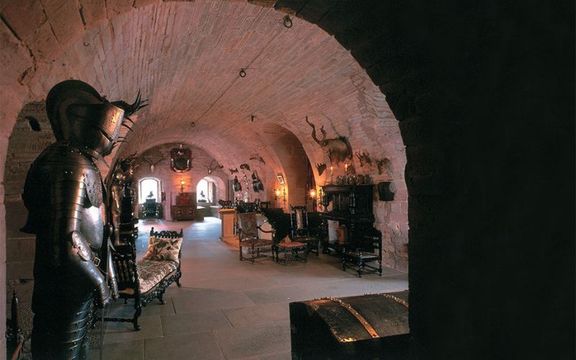
Courtesy of the Strathmore EstateSTRATHMORE ESTATE
Ghosts galore, Shakespeare lore, and Royal roots at the most haunted place in Scotland.
With its towers and turrets, Glamis Castle near Forfar in East Scotland looks for all the world like something from a fairy tale, an impression that is perhaps closer to the truth than many people might imagine.
From the first glimpse of the castle as they drive up the tree-lined avenue, visitors can sense the history and legend oozing from the fabric of this fine building. Although some parts are off limits to the public, (it is a family home after all), the public areas provide a wonderful insight into aristocratic life through the ages.
According to legend, the first attempts to build a castle at Glamis on nearby Hunter’s Hill were thwarted by the “little people.” Hunter’s Hill was their special place, and each night, after the builders had finished, they would take down the stones so that there was no trace of the building work left by the following morning. This went on for some time until the builders took the hint, and Glamis was built on its present site.

COUTESY OF THE STRATHMORE ESTATE
‘WHETHER YOU ARE A BELIEVER IN GHOSTLY ACTIVITY OR NOT, GLAMIS CASTLE IS A TIME MACHINE, WITH OR WITHOUT FAIRIES AND PHANTOMS’
Originally, Glamis was a hunting lodge used by the kings of Scotland as a base when they were in the northeast of the country. King Malcolm II died at Glamis in 1034, probably from wounds sustained in a nearby battle rather than as a result of an assassination attempt, and the event is commemorated by King Malcolm’s room. This room is certainly not the original, but it is thought to be on a site close to where he breathed his last in the old hunting lodge.
Duncan’s Hall, another eerie part of the old castle, is the traditional scene of the murder of Malcolm’s successor, Duncan I, who was actually killed by Macbeth—although the act took place during a battle fought near Elgin in 1040. Later, William Shakespeare, who is reputed to have visited Aberdeen in 1599, decided to incorporate these bloody goings-on in his own version of Scottish history. Perhaps even then Glamis had a reputation for paranormal activity, which encouraged the Bard to incorporate the stories into Macbeth. Certainly, the Glamis connections with the most famous ghost in English literature are a fabrication.
The Lyon family, now headed by the Earl of Strathmore and Kinghorne, has lived at Glamis since 1372, the year in which John Lyon, later Sir John, was granted the thanage of Glamis by King Robert II. Four years later, Sir John married Robert’s daughter, Princess Joanna, the first of many associations with the Royal family.
It was their son, also Sir John, who started work on the present castle, so that the original parts of the castle are themselves monuments to over 600 years of history.
Like so many historical buildings, Glamis Castle is reputed to be haunted, and it can lay claim to being the most haunted building in Scotland if not the UK.
The crypt, decorated with suits of armor, big game heads and even a saddle dating from Cromwell’s occupation of the castle, is one of the oldest parts of the building. Its thick walls are said to incorporate a small room that features in one of the most famous paranormal stories associated with Glamis.
That room is said to be where Lord Glamis was playing cards with the Earl of Crawford, who was also known as “Earl Beardie,” one Saturday evening. The card game continued late into the night until Saturday passed into Sunday. From that point there are many versions of the story, but the outcome is always the same.
Some say a servant interrupted the two card players and reminded them that it was now the Sabbath, whereupon Glamis is reputed to have said he would play on regardless. Other versions have Glamis or Beardie offering to gamble with the Devil himself. Again, versions of the tale differ. Some have a tall, darkly clothed stranger arriving at the gate seeking admission to the castle while others simply have him appearing in the chamber.
One way or another, the Devil arrived to take part in the card game, after which strange noises were heard coming from the room. The noises persisted for years until, eventually, after some 300 years, the family decided they could no longer put up with the strange sounds and had the room filled in and its entrance closed up. Some believe that Beardie, having lost his soul to the Devil in the card game, still haunts the castle. Whatever the reason, strange noises can still be heard from the room on Saturday evenings—perhaps the card game has still to be finished.
Another legend is the “Gray” or “Praying Lady,” a spirit generally thought to be that of Lady Janet Douglas, the wife of the 6th Lord Glamis. James V of Scotland was thought to have had a grudge against the Douglas family, or he might simply have coveted the lands and castle of the family and resolved to have them for himself. Irrespective of James’ motives, when her husband died in 1528, Lady Janet no longer had the protection of Lord Glamis, and she was taken to Edinburgh to stand trial for witchcraft.
By all accounts, there was no substance to the charge. Lady Janet was said to have a kindly disposition, but torture was allegedly used to extract a confession from her, a normal practice of the time that persisted in the witch hunts of the 17th century. In the face of such “evidence,” the unfortunate Lady Janet was found guilty and burned alive at Castle Hill in Edinburgh in 1537.
Her son John was held prisoner, and if he, too, had died, the lands might well have reverted to the King. In fact, it was James V who died, in 1542, and eventually the young John was released by an Act of the Parliament of Scotland. He was then able to return to Glamis and claim his rightful inheritance.
Many people say they have seen the figure of a woman dressed in a gray robe praying in the Chapel, so perhaps Lady Janet returned to Glamis to keep a motherly eye on her son and heir. Legend requires that visitors knock three times on the chapel door before entering, to warn Lady Janet of their presence.
The Chapel, built in the late 17th century and still used by the family today, features in another piece of folklore. It was there that the Old Pretender, or James VIII to Jacobite supporters, “cured” people of scrofula, a glandular disease that causes growths in the neck, also known as the King’s evil. The Chapel displays a number of fine paintings, including one of the risen Christ being mistaken for a gardener, which unusually depicts him wearing a hat.
In modern times, the castle has become best known as the childhood home of Elizabeth Bowes Lyon, the late Queen Mother and her elder daughter Queen Elizabeth, as well as being the birthplace of the late Princess Margaret.

COUTESY OF THE STRATHMORE ESTATE
Planning a Visit to Glamis
Glamis Castle, Glamis, Angus DD8 1RJTel: 01307840393 • www.glamis-castle.co.uk
Some 4,500 acres of the estate itself are largely given over to farming, with pigs, sheep and highland cattle among the animals reared there. The nearby village of Glamis is home to a Folk Museum and preserved cottages that give visitors an insight into rural life in a bygone age.
When Elizabeth married the Duke of York, who later succeeded Edward VII as George VI, her mother converted three bedrooms into a separate suite for use by the Royal couple when they visited Glamis. This is where the ghost of a young pageboy, who was rather too mischievous for his own good, is said to lurk. Having got himself into a bother just once too often, he was ordered to sit on a seat, a stone slab that juts out from the wall, outside what is now the Queen Mother’s sitting room. Unfortunately, he was forgotten about until morning when his stiff, frozen body was discovered.
Another account suggests that the pageboy was black, while yet another relates how he still possesses the same mischievous streak that got him into trouble in the first place. If this last version is to be believed, he still sits on his seat and stretches a leg out to trip the unwary. In fact, there is a small step near the seat which causes many people to stumble. Victims of the mischievous pageboy?
These days, the family is looking to move away from the paranormal tales, arguing that there is no evidence of ghostly activity. Nevertheless, whether you are a believer or not, Glamis Castle is like a time machine, which, with or without fairies and phantoms, tells the story of one of Scotland’s most notable aristocratic families. What more could any visitor ask?
* Originally published in 2016. Updated in 2023.





Comments